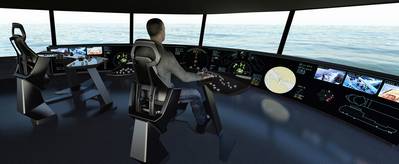Ulstein Bridge Vision Debuts
With the internal mandate to create better, safer and simpler solutions for ships’ crews, Ulstein introduces its patent-pending Ulstein Bridge Vision – a concept that promises major improvements for the operational centers of vessels.
Ulstein Bridge Vision offers a catalog of innovations, including:
- Gesture-controlled infographics displayed on bridge windows;
- a system that automatically adapts to the individual user’s preferred setup; and
- a new breed of user-defined ergonomic work stations.
Arne Ove Rødstøl, Product Manager Bridge in Ulstein Power & Control, explained that Ulstein engineers sought the expertise of industrial, graphic and interaction designers from The Oslo School of Architecture and Design (AHO). “Together, we’ve created a human-centred operational environment for the future ship bridge. Our focus throughout has been on the user, and the concept includes work space designs and new ways to interact with bridge systems.”
Ulstein Bridge Vision future work stations offer unique ergonomic benefits through the combination of an innovative bridge chair design, with multiple sitting positions, and a new, ground-breaking console design. In addition, the new bridge adapts both the workspace and software setup to the individual user’s specific requirements.
Window on the Future
An eye-popping element of the pioneering system is the use of optical projections. These allow vital information to pop up directly on the windows (full frame head-up display) on the aft bridge and on seamless monitors directly below the windows on the front bridge. Operators can then access controls and information by using intuitive touch-commands and gestures.
The optical projection of information provides the users with all relevant details related to an operation in their line of vision, improving their ability to safely operate the vessel. It also makes coordination between crew members performing interdependent operations much simpler, as they can see the same information even though they positioned apart from one another.
“Captains often say that the most important information is outside the ship. The beauty of Ulstein Bridge Vision is that you do not have to choose between internal and external information because both can be viewed simultaneously,” Rødstøl said.
The system prioritizes information based on the operation and situation of the ship. For example, when the ship is in transit mode, illustrations will be presented on a large, seamless surface below the windows on the front bridge. A real-time overlay is also possible, where the head-up display provides information on operationally critical tasks by showing elements the user cannot spot directly, such as fog, darkness or elements hidden behind objects. The display systems can also turn the bridge into a simulator for training or preparation before a critical operation.











